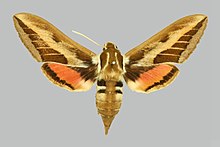Hyles nervosa
| Hyles nervosa | ||||||||||||
|---|---|---|---|---|---|---|---|---|---|---|---|---|

Hyles nervosa , male |
||||||||||||
| Systematics | ||||||||||||
|
||||||||||||
| Scientific name | ||||||||||||
| Hyles nervosa | ||||||||||||
| ( Rothschild & Jordan , 1903) |
Hyles nervosa is a butterfly ( moth ) fromthe swarm family (Sphingidae).
features
The moths have a wingspan of 68 to 87 millimeters. In the males, the tegulae are fringed white, the abdomen has only two black spots on the sides and the edge of the tergite is not colored white in the middle along the back. Dorsally , the wing veins of the forewings are drawn in white in the post-disc area.
The eggs are almost spherical and pale green in color, making them look similar to the eggs of Hyles euphorbiae euphorbiae .
The caterpillars are 80 millimeters long. They are initially four millimeters long and have an off-white color with a black anal horn and the same colored head. In the second stage, the color that predominates in the last stage occurs: the caterpillars are mainly black with small, white to pale yellow spots. On both sides of the back there is a line consisting of one white eye spot per segment. This runs from the white dotted head to the deep black anal horn. Carapace, post shifter and abdominal legs are black and center back runs from head to Analhorn an imperforate as black longitudinal line. A line of medium-sized yellow spots also runs ventrolaterally. In contrast to the milkweed hawk , the color of the caterpillars is only slightly or not at all variable.
The pupa is about 45 millimeters long and looks very similar to that of the milkweed hawk. However, their head, thorax and wing sheaths are colored dull green.
Occurrence
The species occurs in eastern Afghanistan, northwest India, northern Pakistan, and the far west of Tibet. It is only distributed locally, but can occur in very large numbers. In the Kashmir region, they are found between 2500 and 3000 meters above sea level where herbaceous milkweed species grow.
Way of life
The species appears to occur in three generations per year from March to May, June and July and in September. The caterpillars are found from April to October, with the maximum from June to August.
Food plants of the caterpillars
The caterpillars feed on herbaceous milkweed species ( Euphorbia ).
development
The females lay their eggs in small groups of up to 20 on young shoots of the food plants. The caterpillars live gregariously and migrate together from one bald-eaten plant to the next. They feed fairly openly, although almost fully grown they tend to rest on the stem of the food plants, close to the ground. When disturbed, the caterpillars all choke up a green liquid together. This behavior presumably serves to protect against parasitoid caterpillar flies , although these are not known in the species. The wintering takes place as a pupa.
